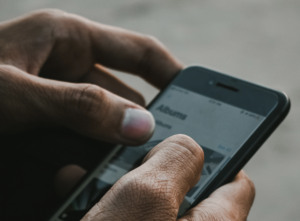Understanding EMFs and How to Protect Yourself

It is almost never left behind. Whether in your bag, back pocket or plugged in and resting on your bedside table while you sleep, you usually know where your cell phone is. As one of the most commonly used electronic devices, almost everyone has a cell phone. However, this device, which is typically a preferred method of communication, could cause your body more harm than you would think.
Similar to how the sun gives off radiation, cell phones and other electronic devices such as tablets and laptops emit radio waves that create electric and magnetic fields (EMFs). Invisible to the naked eye, these streams of energy, in excess, can be harmful to the human body and it is important that people take the proper steps to protect themselves, especially as the hourly use of cell phones increases.
“Anything that communicates wirelessly emits radio waves,” says R Blank, the owner of Shield Your Body, a company that creates EMF protection devices. “Also, anything that runs on power emits lower energy; lower frequency EMF — that’s called ELF or extremely low frequency. So, any modern technology is a source of EMF.”
There are two different types of EMF exposure to be aware of: low-level radiation and high-level radiation. Low-level, or non-ionizing radiation, is what cell phones, Wi-Fi routers and other appliances send out. High-level radiation, or ionizing radiation, is sent out through medical imaging machines like X-rays and ultraviolet rays from the sun.
While generally not as dangerous as high-level radiation, low-level radiation still poses a potential danger.
While we’ve only been around carrying cell phones for a few decades, EMFs have been a potential concern for longer. In 1996, the World Health Organization (WHO) created the International EMF Project as a result of public health concerns about the effects of EMF exposure. The project aims to “assess the scientific evidence of possible health effects of EMF in the frequency range from 0 to 300 GHz.”
An integral part of today’s communication, it is key to understand how mobile phones work in order to understand the potential radiation risks involved. To communicate, mobile phones transmit radio waves through a network of base stations, which are fixed antennas. These radiofrequency waves are EMFs.
According to the WHO, “All populations are now exposed to varying degrees of EMF, and the levels will continue to increase as technology advances.”
With more and more of the world population using phones and other devices that emit EMFs, there is increasing and growing concern.
“In essence, EMF can negatively impact every biological system,” Blank says. “So, you see results on the less severe side, including anxiety, depression and sleep disruption. Then, escalating to conditions like infertility and then more serious conditions like tumors and cancers.”
In 2011, the WHO’s International Agency for Research on Cancer (IARC) released a press release titled, “IARC Classifies Radiofrequency Electromagnetic Fields as Possibly Carcinogenic to Humans.” The document goes on to state that the IARC had found links between the EMFs present in cell phones and tablets and certain types of cancer, specifically glioma and acoustic neuroma.
Similarly, there have been multiple other studies that test the link between EMFs/cell phone use and cancer.
The INTERPHONE international case-control study published in 2010 found that “there were suggestions of an increased risk of glioma at the highest exposure levels.” Additionally, the study noted that glioma, a tumor found in the brain and spinal cord, tended to be on the same side of the body that the patient usually used to talk on a phone. Ultimately, the researchers concluded that the evidence did not prove a strong enough link to determine that cell phone use caused the cancer.
In 2018, a Swiss National Cohort analysis found an increased risk of developing leukemia in those exposed to high levels of EMFs for years at a time.
There have also been studies that connect EMFs and other types of cancer, such as breast cancer, thyroid cancer and prostate cancer.
Furthermore, a study published in 2016 found a link between low-frequency EMFs and human nerve function changes. These changes, which occurred throughout the body, affected mood and sleep.
After finding out that his house’s electrical meter was causing his wife’s atrial fibrillation attacks, Steve Richards, who has a B.S. in experimental psychology from the University of Houston and specialized in research associated with the biochemical transference of memory, dedicated his life to the study of EMFs and their impact on humans. Seven years later, he and his wife, Rockie, own EMF Resources, an EMF consulting company located in Spicewood.
“We’re just being inundated and flooded with stuff [our] body cells aren’t used to and aren’t designed to handle,” Richards, a certified EMF expert, says. “For example, nobody had a cell phone 30 years ago and everybody has one now. That type of radiation puts out what we call square waves. It’s like hitting yourselves with a little mallet, all the time.”
To protect yourself from EMFs, Richards says the first step is simply knowing that they exist. Once the problem is recognized, one can reduce their exposure to EMFs or consult a professional to discuss what the next steps toward protecting yourself and others in your home look like.
A professional EMF consultant will be able to come into your home and identify potential radiation risks while also posing solutions to help decrease exposure.
“Radiofrequency radiation is what all this stuff falls under,” Richards explains. “It can be remediated with various filters, fabrics and materials that will block it.”
Blank explains that he has two key rules when it comes to EMF protection: minimize and maximize. He says that in order to best protect yourself, you want to minimize your use of EMF emitting technology and you want to maximize the distance of it from your body.
“Obviously, we live in 2021 and we’re surrounded by tech,” Blank says. “I’m not telling anyone to give up tech, but there’s a growing amount of tech that we don’t really need. I think it includes things like smartwatches and AirPods, but it also includes things like smart fridges and smart kitty litter boxes. All of this tech that is coming up is converting traditional analog products into additional sources of EMF in our lives.”
Blank goes on to explain that the reason maximizing your distance is important is because the power of EMF radiation diminishes exponentially with distance.
“If you double the distance then you’re cutting the power of the exposure by 75%,” Blank says. “Distance is really your friend.”

In the case of a cell phone, EMF exposure can be reduced through distance by putting your phone in another room while you sleep, reducing the use of earbuds, and not carrying your phone in your pocket, bra or tucked in your waistband.
It is important to be vigilant and learn as much about the EMFs around you as possible, especially since the number of devices and use of smart technology is only going to increase as it has in the past.
“Over time the man-made EMFs at the cell phone frequencies has increased over one sextillion, (100 Trillion), times the natural background levels,” the EMF Resource website states.
Richards, who owns EMF Resource, warns that the situation will only continue to get worse as the latest technology, such as 5G, advances and becomes more popular. So, everyone must be vigilant in understanding more about EMFs and taking the proper steps toward protection.
How to limit your exposure to EMFs:
- Put your phone on airplane mode or in another room while you sleep
- Carry your phone in a bag, not in your pocket or on your body
- Turn off your Wifi during the night
- Never put a laptop or tablet directly on your lap
- Talk on your phone using the speakerphone function
- Limit wear AirPods or other earbuds
- Move Wifi router at least 20 feet away from the bedroom, desk and other highly populated areas
- Research and purchase protection products for devices you use often






